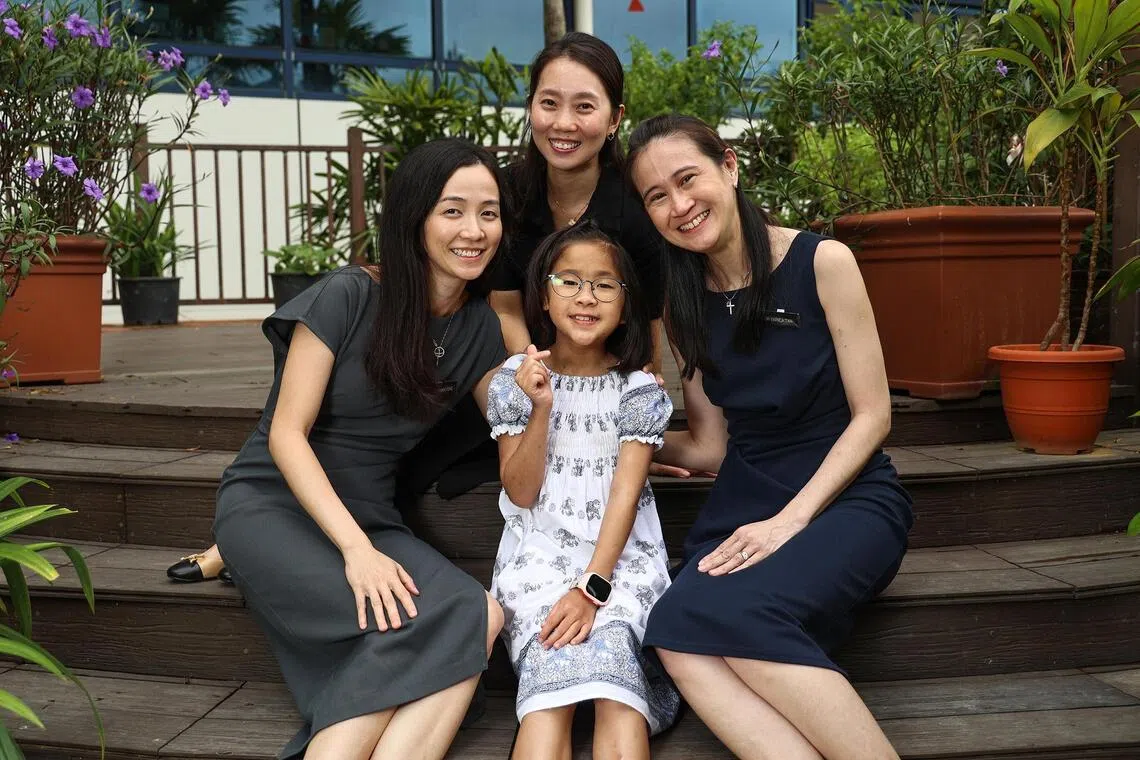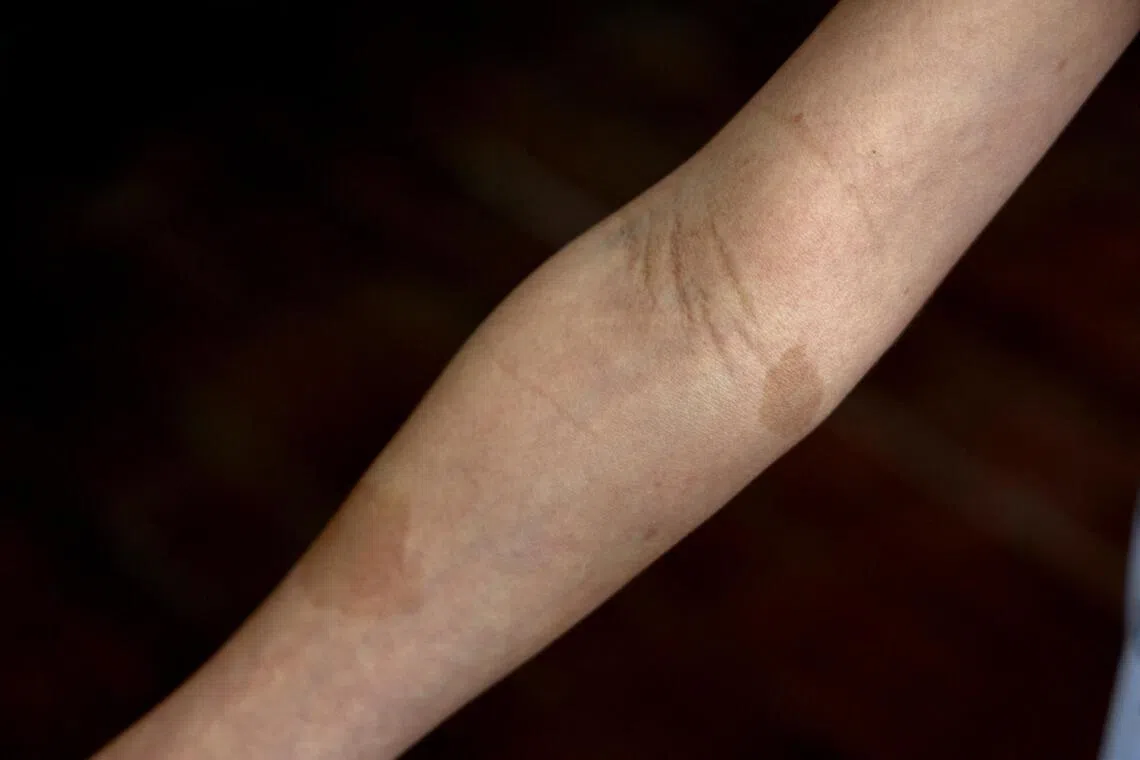Medical Mysteries
Rare skin condition gives 9-year-old girl skin like K-Pop Demon Hunters character
Medical Mysteries is a series that spotlights rare diseases or unusual conditions.
Sign up now: Get ST's newsletters delivered to your inbox

Phoebe Hu with her doctors (from left) Nikki Fong, Valerie Ho and Enrica Tan at KK Women’s and Children’s Hospital on Oct 21.
ST PHOTO: HESTER TAN
Follow topic:
- Nine-year-old Phoebe Hu was diagnosed with neurofibromatosis type 1 (NF1) after experiencing pain and displaying "cafe au lait" spots.
- NF1 patients need regular monitoring due to a higher cancer risk, up to 40 per cent by age 50, according to Dr Chiang from NCCS.
- Phoebe is managing her pain and tumours with Selumetinib and receives multidisciplinary care including psychological support.
AI generated
SINGAPORE - Where the marks on Rumi from Netflix’s animated film K-pop Demon Hunters are purple, those on nine-year-old Phoebe Hu’s arms and body are light brown.
As a result, she is often bullied in school, with her schoolmates making unpleasant remarks about her skin.
Often called “cafe au lait” spots by doctors, the flat, light-to-dark brown birthmarks that resemble “coffee with milk” on Phoebe’s skin are the underlying signs of a genetic condition known as neurofibromatosis Type 1 (NF1).
NF1 causes changes in skin pigment, including flat, light-brown spots and freckles on the armpits and groin. It also causes the growth of benign, slow-growing tumours that develop on or under the skin from nerve cells. These tumours, called NF tumours, can appear as soft lumps throughout the body.
Phoebe’s condition was discovered when she began having pain behind her left ear around March 2023, her mother Pearlyn Goh, 42, said.
She was brought to KK Women’s and Children’s Hospital (KKH), and an MRI scan, three doctors and a genetic test later, Phoebe was diagnosed with NF1.
“Apart from the brown spots on her arms and parts of her body, the scan also showed that Phoebe has a tumour behind her left ear and another near her brain stem,” Madam Goh said.
She told The Straits Times that her research revealed that children with NF1 often have special needs related to learning, such as difficulties with attention and memory. However, Phoebe does not exhibit these difficulties, which is a relief, she shared.
Dr Nikki Fong, a geneticist with KKH, explained that there is a 50 per cent likelihood of NF1 being passed on if one parent has it.
“It can also occur spontaneously from a new gene change,” she said, referring to what is also known as gene mutation.

The “cafe au lait” spots on nine-year-old Phoebe Hu’s arm – a cause for her becoming a victim of bullying in school.
ST PHOTO: HESTER TAN
Subsequent investigations revealed that Phoebe’s father James Hu, 43, a taxi driver, also has the condition, though his was not inherited from either of his parents.
Like Phoebe, Mr Hu has the “cafe au lait” spots only on his arms, legs and body, “except for this large lump at the back of my head, which is a benign NF tumour”, he told ST.
“As I did not know what it was, it was not detected until adulthood,” he added.
According to Clinical Assistant Professor Chiang Jianbang from the Cancer Genetics Service at the National Cancer Centre Singapore (NCCS), the adult patients seen at NCCS typically fall into one of two categories: those who were not diagnosed during childhood and those who, despite an initial childhood diagnosis, did not pursue follow-up care as they grew older.
Dr Chiang said that as young NF1 patients transition into adulthood, they often feel capable of managing their own health and symptoms, leading them to believe that regular follow-up appointments are no longer necessary.
He said that it is important for NF1 patients to be regularly monitored as they are at a higher risk for hypertension and various cancers.
“By the age of 50, the risk of cancer in NF1 patients can be as high as 40 per cent, compared with the 5 per cent in the general population,” he said.
Treatment for NF1 focuses on supporting healthy growth and development in children and early management of complications.
Dr Enrica Tan, a senior consultant with the Haematology and Oncology Service at KKH, said: “Phoebe was also in a lot of pain, and the pain was making her sick.”
The painkillers she was previously prescribed were not effective and also impacted her appetite.
Phoebe is now prescribed selumetinib, a medication that treats the benign tumours – called plexiform neurofibromas – in children with NF1. It stops the growth of the tumours and shrinks them, improving pain and other symptoms.
“She is good at taking her meds and takes them like clockwork. She wakes up early to ensure she takes her medicine at 6.45am before school on weekdays, and at 7pm. On weekends, she wakes up a bit later and takes them at around 9am without prompting,” Madam Goh said.
Paediatric dermatologist Valerie Ho, a senior consultant at KKH’s department of dermatology, manages Phoebe’s skin condition as there is a need to monitor closely for potential side effects from the medication such as dry skin, eczema and acne.
As Phoebe grows, she would have to be monitored for other manifestations of the condition such as scoliosis or the curvature of the spine, one of the more common deformities of NF1.
“This is why children with NF1 need to be managed by a multidisciplinary team, which also includes a psychologist to manage the psycho-social impact of the condition,” she added.
Madam Goh explained that to help Phoebe understand that apart from her father and herself, there are others who also live with NF1, the family attends events organised by the Neurofibromatosis Society (NFS) Singapore and by KKH. NFS is a new patient-led group formed to support individuals with neurofibromatosis.
“There, she has made friends with other children who have similar spots to hers. At least she knows she is not alone in this fight against her own ‘demons’,” her mother said.


